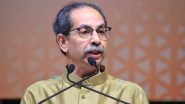Panaji, Nov 23 (PTI) Oscar winner John Seale, known for his work on films such as "The English Patient", "Mad Max: Fury Road" and "Harry Potter and the Philosopher's Stone", on Saturday said a cinematographer today is being likened to an illusionist, wondering if the art continues to be about the moving image.
The celebrated Australian technician was speaking at a masterclass at the ongoing International Film Festival of India (IFFI) here.
"I hear under grapevine that a lot of times the cinematographers are called an illusionist, that you create the images. But is it photography?
"That is the big question that should be answered in each individual's mind as to whether or not it still is photography... But the word illusionist is pretty hard," Seale said.
Also Read | Tamannaah Bhatia and Vijay Varma To Tie the Knot in 2025? Here's What We Know.
The 82-year-old cinematographer, who cut his teeth in the field by working on Australian TV channel ABC, said his training in the 1960s came in handy when he was shooting for Barry Levinson's "Rain Man" (1988), starring Dustin Hoffman and Tom Cruise.
Both the actors were ad-libbing on set which needed to be captured by multiple cameras to make the storytelling effective, he recalled.
"I went to Barry, and I said, 'Barry, we should be cross shooting this with two cameras.' And he looked at me. He said, 'I wasn't going to ask.' I said, 'Give me three minutes.'
"It (cross shooting) helped the actors because they were able to overlap and the editor was able to cut it because it was perfect continuity. All of that made me feel that it was helping to make better films."
Seale, who won the Academy Award for his work on the 1996 film "The English Patient", also recounted collaborating with fellow Australian and director George Miller on "Mad Max: Fury Road" (2015) and "Three Thousand Years of Longing" (2022).
The cinematographer said Warner Bros studio went to Miller with the idea to make a big "3D movie".
But the filmmaker said he had written such shots in the film that no 3D camera built in the world at the time could capture them.
"George said, 'I'll build my own.' So he started building 3D cameras that would fit through the window of the truck, or it would go down through the sky roof, it would fit through the window and fit inside the truck... When you change a lens on a 3D camera, you've got to change two lenses, and then you have to match them up optically perfectly.
"It's a long process, taking 30 minutes to change a lens. So when George got hold of this, he said, 'I can't have that much time wasted on the set.' So they decided to build a 3D camera body for every lens. There were 24 cameras, all with different lenses in them."
But that came with its own set of problems.
"They had a lot of electronic problems, overheating and stuff that we were battling. Then at the last minute, George swung over to 2D," Seale added.
There were 27 members from Europe, Africa, the US, the UK, Australia, and New Zealand, in the camera crew of "Fury Road", he said, revealing that among them was also a Namibian prince.
"He was a young man who wanted to work in films, and he actually was a prince. So we did a lot of bowing," Seale quipped.
As someone who's witnessed the evolution of shooting from film negatives to digital camera, the veteran cinematographer said he finds the new medium "amazing".
"Their latitude, their ability to shoot in low light areas, everything about them was a dream come true after battling through 40 years of film negative," said Seale, who shot "Fury Road" and "Three Thousand Years of Longing" on digital camera.
The cinematographer said whenever the Americans came to work in Australia, they were very pleased as the local crew were easy to work with as well as professional.
"Americans liked the loose way of shooting films... We honoured the budget, because the Australian films, they couldn't afford any overtime. We used to get a cold beer at the end of the day for doing two hours of overtime..."
Australia is the country of focus at the 55th edition of IFFI, which will conclude on November 28.
(This is an unedited and auto-generated story from Syndicated News feed, LatestLY Staff may not have modified or edited the content body)













 Quickly
Quickly

















